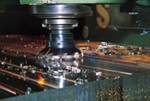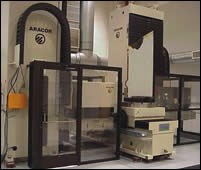Fast Metal Removal Dramatically Increases Productivity
A combination of very minimal setup time, increased tool life, and the ability to run at extremely high feeds made an arbor-style milling cutter a great choice for B&J Specialty, Inc. to use on its roughing projects.
The cycle time for roughing large pieces can be challenging for mold and die shops. Oftentimes the roughing process is a time consuming one that removes a large amount of stock, but still leaves a large amount of work for the finishing tool to do. This leads to increased cycle times and decreased production.
B&J Specialty, Inc. (B&J) (Wawaka, IN)—a manufacturer in the mold and die industry—faced this problem when it needed a tool that could quickly rough pieces while leaving the least amount of stock possible for the finishing tool to remove.
The Challenge
This project involved the roughing of P-20 mold steel 36-40 Rockwell C. The design of the mold to be roughed required more than 2,000 pounds of material to be removed. This heavy-duty roughing project required large amounts of time and resources in order to be completed.
B&J's first production attempt involved spending countless hours—and in some cases—even days roughing out large molds with standard button-type face mills. Originally a four-inch button cutter was used for the roughing process. The inserts typically lasted only about 15 minutes per rotation. This achieved approximately 40 ipm taking a .035" depth-of-cut in the hardened P-20 tool steel. The performance of this cut was far from what B&J needed. Its project required the roughing of a piece 30 inches by 48 inches and more than 11 inches thick. Furthermore, this roughing cutter had a large corner radius, which meant that the finishing tool would ultimately meet more work. Citing these concerns, B&J set out to find a cutter to rough its molds in a shorter period of time, which also left less stock for the finishing tool to take off. This could help B&J become more efficient and produce a better product for its customers.
A Solution
Upon hearing the roughing problem, B&J's Iscar representative offered some suggestions. The first solution was the four-inch round mill. Initially this produced some astounding results. Using the IC908 grade of inserts, B&J achieved 65 ipm at 450 rpm taking a .05" depth-of-cut. The insert life with this tool quadrupled to at least one hour of rotation per tool. This was up dramatically from the original 15 minutes per rotation with the previous tool. Although these are good results, their Iscar representative believed that metal removal rates could be increased even further.
He next suggested the FEEDMILL for a test, which is an arbor-style milling cutter specially designed for Fast Metal Removal (F.M.R.). A combination of very minimal setup time, increased tool life, and the ability to run at extremely high feeds made the FEEDMILL a great choice for B&J to use on its roughing projects.
The FEEDMILL family of tools uses a special type of trigon-shaped insert that enables it to carry up to a .138" per tooth load. The trigon shape of the insert uses a large radius, cutting edge configuration that allows the tool to be run at such high feeds while carrying a large amount per tooth. In addition, the insert is designed with a cylinder on the bottom that is seated in a matching hole in the pocket. This enables the inserts to bear higher cutting forces, which allow it to run at higher than normal feedrates. With this design, the insert is much more rigidly clamped and thereby works to relieve most of the stresses that are normally placed on the clamping screw. The cutting forces are then directed axially toward the spindle helping to provide stability even when machining with a long overhang.
Deep cavity milling is made even easier if the FEEDMILL is used with the new long-reach BT and DIN69871 tapered shanks that are specially designed for fast feed tools in deep cavity applications. These shanks allow for increased stability and improved chip evacuation.
This new setup allowed B&J to dramatically increase productivity and become much more efficient on its roughing projects—roughing an entire mold at a much higher feedrate, and without replacing a single insert. As one machinist states, "The feedrate was what really impressed us, especially when you are hanging out eight inches from the spindle. We were able to run at 800 rpm and 250 ipm taking .040 depth-of-cut with the 2.5-inch FEEDMILL."
With the previous setup B&J was using 16-mm round inserts that left a large radius while cutting. Keeping the same IC908 grade of inserts, B&J was able to attain insert life of 45 minutes per rotation. "With this kind of performance we knew we had a solution," explains Engineering Manager Jim Reed.
When searching for new tooling B&J has a short list of cutter considerations (see Cutter Considerations sidebar). All of these were taken into account when upgrading to the new FEEDMILL. By using Iscar's FEEDMILL, B&J Specialty Inc. was able to dramatically reduce set up time, increase tool life and shorten cycle time.
Related Content
2024 Moldmaking Insights: A Year in Review Part 1
A look back at the top moldmaking trends of 2024, as revealed through MMT's analytics. This review highlights the most popular technical articles, case studies, tips and best practices that captured the industry's attention over the past year.
Read MoreHow to Overcome Deep-Hole Drilling Obstacles in Mold Machining
Keep up with the newest tooling innovations to overcome holemaking and finishing challenges.
Read MoreWhy Mold Builders Should Consider Barrel Cutters and Lens Tools If They Haven’t Before
Reduce machining cycle times and improve surface finishes of cavity and core work with barrel cutters and lens tools.
Read More6 Ways to Optimize High-Feed Milling
High-feed milling can significantly outweigh potential reliability challenges. Consider these six strategies in order to make high-feed milling successful for your business.
Read MoreRead Next
Milling Advances Increase Productivity
Keeping on top of new advances in cutting tools can keep moldmakers profitable.
Read MoreHow to Use Continuing Education to Remain Competitive in Moldmaking
Continued training helps moldmakers make tooling decisions and properly use the latest cutting tool to efficiently machine high-quality molds.
Read MoreHow to Use Strategic Planning Tools, Data to Manage the Human Side of Business
Q&A with Marion Wells, MMT EAB member and founder of Human Asset Management.
Read More



























